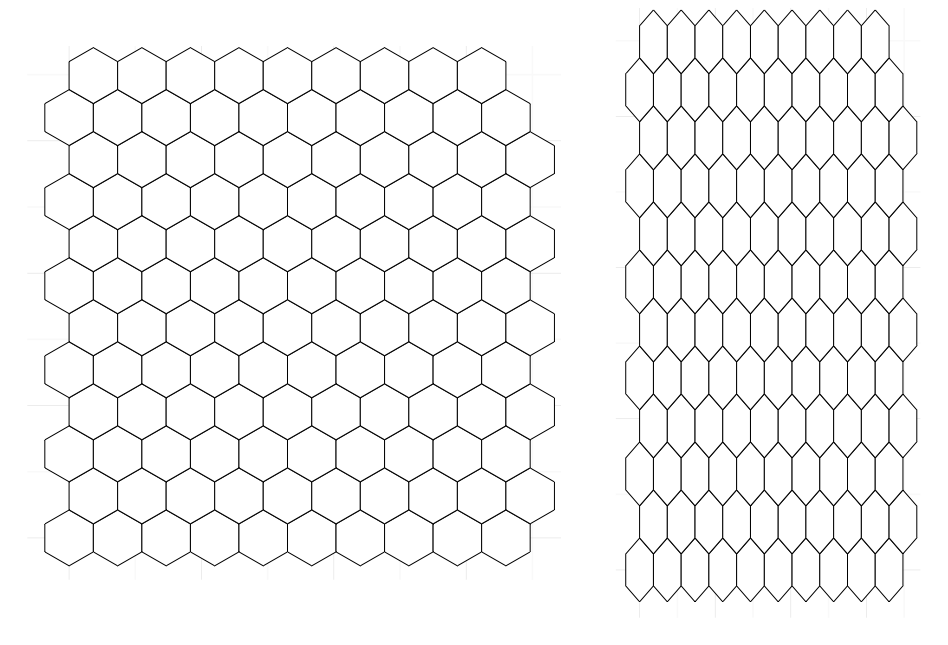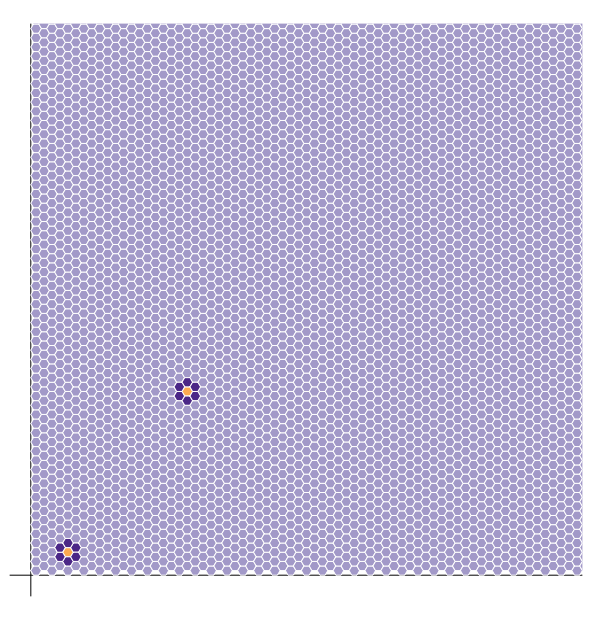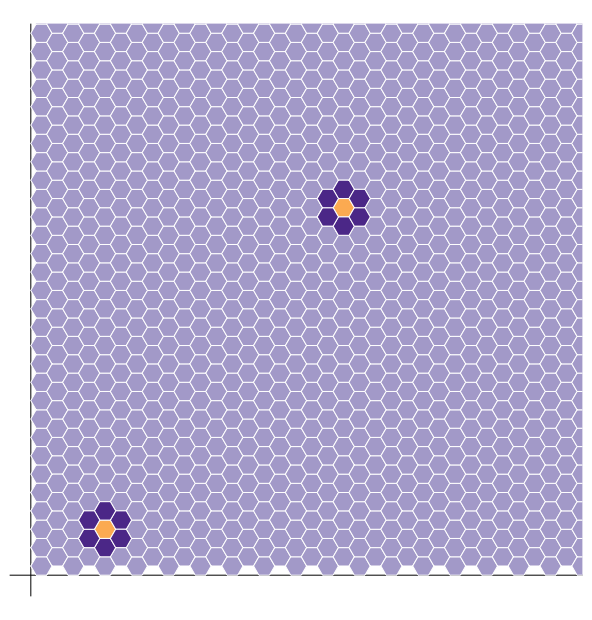R - Построение шестигранных тесселяций
Я хотел бы создать несколько квадратных графиков, в которых есть массивы шестиугольников, как показано здесь. Я хотел бы построить как регулярные (геометрически правильные), так и ненормальные шестиугольные тесселяции, поэтому я не думаю, что инструменты из пакета sp будут работать.
Ниже моя попытка регулярного тесселяции шестиугольника, используя owin и заговор.
library(maptools)
library(spatstat)
twid <- 20
theight <- 20
sideL <- 2
rp1 <- (sideL/2)*sqrt(3)
rp2 <- 2*(sideL/2)*sqrt(3)
rp3 <- 3*sideL
bx <- c(1:floor(twid/rp3))
by <- c(1:floor(theight/rp3))
hex_array1 <- list(bx)
hex_array2 <- list(by)
for(i in 1:ceiling(twid/rp3)){
bx[i] <- list(x=c(0+rp3*i,1+rp3*i,3+rp3*i,4+rp3*i,3+rp3*i,1+rp3*i))
by[i] <- list(y=c(rp1,rp2,rp2,rp1,0,0))
hex_array1[i] <- bx[i]
hex_array2[i] <- by[i]
}
har1 <- list(x=c(0,1,3,4,3,1), y=c(rp1,rp2,rp2,rp1,0,0))
har2 <- list(x=hex_array1,y=hex_array2)
hexig <- owin(poly=list(list(x=c(0,twid,twid,0), y=c(0,0,theight,theight)),
har1, har2
)
)
plot(hexig)
Однако вышеприведенное кажется ошибочным, поскольку har2 неправильно отформатирован как список списков.
Вышеприведенное, очевидно, относится только к одному ряду шестиугольников, но я подумал, что, получив первую строку, я просто оберну одну строку в цикле for, который добавляет набор расстояний x и y для каждой строки. Я просто не могу понять, как отформатировать har2, чтобы я мог напрямую подключить его к функции поли в owin.
Я открыт для того, чтобы полностью изменить способ, которым я сделал выше, я все еще относительно новичок в R, поэтому я определенно все еще не знаю, как сделать вещи наиболее эффективным / элегантным способом. В настоящее время я использую версию R 3.3.2 на Win 10 x64 под управлением RStudio V0.99.903
Любая помощь приветствуется.
Спасибо!
3 ответа
Я думаю spatstat имеет только те функции, которые вы ищете: hextessа также affine.tess,
Посмотрите на примеры для affine.tess, Вот пример того, что вы можете сделать (добавить trim = FALSE чтобы избежать ограничительной рамки):
library(spatstat)
H <- hextess(square(5), 0.2)
plot(H)

shear <- matrix(c(1,0,0.6,1), 2, 2)
sH <- affine(H, shear)
plot(sH)

Возможно, было бы проще просто построить гексбиновый график, а затем переопределить раскраску (не то, чтобы не было интересным программирование для непосредственного построения линий тесселяции шестиугольника). Например, используя ggplot2:
library(ggplot2)
dat = data.frame(x=runif(5000, 0,10), y=runif(5000,0,10))
# Basic plot
p = ggplot(dat, aes(x,y)) +
geom_hex(colour="black", fill="white", bins=10) +
theme_minimal() +
guides(fill=FALSE) +
scale_y_continuous(limits=c(-0.4,10.6)) +
scale_x_continuous(limits=c(-0.4,10.6)) +
theme(axis.text=element_blank(),
axis.title=element_blank())
# Regular hexagons
p + coord_equal(ratio=1)
# 2:1 aspect ratio
p + coord_equal(ratio=2)
geom_hex работает только с декартовыми координатами, поэтому этот метод может производить только шестиугольники с различными пропорциями, но не сдвиг или другие искажения.
масштаб = 1
масштаб = 2
Я написал
hexagon() функция, которая является базой
graphics::polygon()подход. Просто нужно было немного выяснить геометрию шестиугольников и сопоставить ее с индексированием, которое имело смысл. Вот что я придумал:
Шестиугольник - это нижний левый шестиугольник. Его крайняя левая вершина находится в декартовой координате (0,
opp). Он будет заподлицо на линии y = 0 (ось x).В
index_i = 2, index_j=1Шестиугольник будет примыкать справа от шестиугольника (внизу слева). Он будет немного приподнят.В
index_i=1, index_j=2будет прямо на вершинеindex_i = 1, index_j=1шестиугольник (внизу слева).Таким образом, увеличивая ссылочные шестиугольники вправо (подумайте о
index_iв качестве позиции координаты x) и увеличивая ссылочные шестиугольники выше (подумайте оindex_jв качестве координаты y).scaleделает их больше или меньшепередать цвета каждому шестиугольнику с помощью
fill_colorИспользуйте двойной цикл for для тесселяции
library(RColorBrewer)
mypalette<-brewer.pal(5,"PuOr")[c(-1,-3)]
lwd.in<-1
hexagon<-function(index_i=1, index_j=1, scale=1, fill_color=sample(rev(mypalette)[2],1)){
opp=tan(pi/3)*scale;
adj=1*scale;
side_length <- sqrt(adj^2+opp^2)
vertex_a <- c( 0 , opp)
vertex_b <- c(adj , 2*opp)
vertex_c <- c(adj+side_length , 2*opp)
vertex_d <- c(adj+adj+side_length, opp)
vertex_e <- c( adj+side_length , 0)
vertex_f <- c(adj , 0)
cpoint <- c(adj+0.5*side_length,opp)
if( index_i %% 2 == 1){
odds_up_to_index_i <- seq(1,index_i,by=2)
key <- data.frame( i = seq(from=0, by=3, length.out = length(odds_up_to_index_i)),
index_i = odds_up_to_index_i)
i <- key$i[key$index_i == index_i]
j <- 2*(index_j - 1)
return_hex <-
polygon(x = c(vertex_a[1],vertex_b[1],vertex_c[1],vertex_d[1],vertex_e[1],vertex_f[1]) + cpoint[1]*i,
y = c(vertex_a[2],vertex_b[2],vertex_c[2],vertex_d[2],vertex_e[2],vertex_f[2]) + cpoint[2]*j,
col=fill_color,
lwd=lwd.in,
border=sample(c("white","black")[1],1)
)
}
if( index_i %% 2 == 0){
i <- index_i - 1
j <- 2*(index_j - 1)
return_hex <-
polygon(x = c(vertex_a[1],vertex_b[1],vertex_c[1],vertex_d[1],vertex_e[1],vertex_f[1]) + (cpoint[1]+0.5*side_length)*(i),
y = c(vertex_a[2],vertex_b[2],vertex_c[2],vertex_d[2],vertex_e[2],vertex_f[2]) + cpoint[2]*(j+1),
col=fill_color,
lwd=lwd.in,
border=sample(c("white","black")[1],1)
)
}
}
par(pty="s", mai=c(0,0,0,0)+0.1)
plot(NA,NA,xlim=c(0,200),ylim=c(0,200), axes = FALSE, xlab="", ylab="") ## if you adjust `opp` and `adj` from (7,4)
#box()
abline(v=0)
abline(h=0)
for(i in 1:100){
for(j in 1:100){
hexagon(index_i = i, index_j = j)
}
}
hexagon(index_i = 1, index_j = 1)
hexagon(index_i = 1, index_j = 2)
hexagon(index_i = 1, index_j = 3)
hexagon(index_i = 1, index_j = 4)
hexagon(index_i = 1, index_j = 5)
hexagon(index_i = 2, index_j = 1)
hexagon(index_i = 2, index_j = 2)
hexagon(index_i = 2, index_j = 3)
hexagon(index_i = 2, index_j = 4)
hexagon(index_i = 2, index_j = 5)
hexagon(index_i = 3, index_j = 1)
hexagon(index_i = 3, index_j = 2)
hexagon(index_i = 3, index_j = 3)
hexagon(index_i = 3, index_j = 4)
hexagon(index_i = 3, index_j = 5)
hexagon(index_i = 4, index_j = 1)
hexagon(index_i = 4, index_j = 2)
hexagon(index_i = 4, index_j = 3)
hexagon(index_i = 4, index_j = 4)
hexagon(index_i = 4, index_j = 5)
hexagon(index_i = 5, index_j = 1)
hexagon(index_i = 5, index_j = 5)
hexagon(index_i = 6, index_j = 1)
hexagon(index_i = 6, index_j = 4)
hexagon(index_i = 7, index_j = 2)
hexagon(index_i = 7, index_j = 3)
hexagon(index_i = 7, index_j = 4)
## Infected: color, white border
hexagon(index_i = 5, index_j = 3, fill_color=rev(mypalette)[3])
## Vaccinated: deeper color, black border (nah, just white)
hexagon(index_i = 5, index_j = 2, fill_color=rev(mypalette)[1])
hexagon(index_i = 6, index_j = 3, fill_color=rev(mypalette)[1])
hexagon(index_i = 6, index_j = 2, fill_color=rev(mypalette)[1])
hexagon(index_i = 5, index_j = 4, fill_color=rev(mypalette)[1])
hexagon(index_i = 4, index_j = 2, fill_color=rev(mypalette)[1])
hexagon(index_i = 4, index_j = 3, fill_color=rev(mypalette)[1])
## Infected: color, white border
hexagon(index_i = 20, index_j = 20, fill_color=rev(mypalette)[3])
## Vaccinated: deeper color, black border (nah, just white)
hexagon(index_i = 20, index_j = 19, fill_color=rev(mypalette)[1])
hexagon(index_i = 20, index_j = 21, fill_color=rev(mypalette)[1])
hexagon(index_i = 19, index_j = 20, fill_color=rev(mypalette)[1])
hexagon(index_i = 19, index_j = 21, fill_color=rev(mypalette)[1])
hexagon(index_i = 21, index_j = 20, fill_color=rev(mypalette)[1])
hexagon(index_i = 21, index_j = 21, fill_color=rev(mypalette)[1])
par(pty="s", mai=c(0,0,0,0)+0.1)
plot(NA,NA,xlim=c(0,200),ylim=c(0,200), axes = FALSE, xlab="", ylab="") ## if you adjust `opp` and `adj` from (7,4)
#box()
abline(v=0)
abline(h=0)
scale.in <- 2
for(i in 1:100){
for(j in 1:100){
hexagon(index_i = i, index_j = j, scale=scale.in)
}
}
hexagon(index_i = 1, index_j = 1, scale=scale.in)
hexagon(index_i = 1, index_j = 2, scale=scale.in)
hexagon(index_i = 1, index_j = 3, scale=scale.in)
hexagon(index_i = 1, index_j = 4, scale=scale.in)
hexagon(index_i = 1, index_j = 5, scale=scale.in)
hexagon(index_i = 2, index_j = 1, scale=scale.in)
hexagon(index_i = 2, index_j = 2, scale=scale.in)
hexagon(index_i = 2, index_j = 3, scale=scale.in)
hexagon(index_i = 2, index_j = 4, scale=scale.in)
hexagon(index_i = 2, index_j = 5, scale=scale.in)
hexagon(index_i = 3, index_j = 1, scale=scale.in)
hexagon(index_i = 3, index_j = 2, scale=scale.in)
hexagon(index_i = 3, index_j = 3, scale=scale.in)
hexagon(index_i = 3, index_j = 4, scale=scale.in)
hexagon(index_i = 3, index_j = 5, scale=scale.in)
hexagon(index_i = 4, index_j = 1, scale=scale.in)
hexagon(index_i = 4, index_j = 2, scale=scale.in)
hexagon(index_i = 4, index_j = 3, scale=scale.in)
hexagon(index_i = 4, index_j = 4, scale=scale.in)
hexagon(index_i = 4, index_j = 5, scale=scale.in)
hexagon(index_i = 5, index_j = 1, scale=scale.in)
hexagon(index_i = 5, index_j = 5, scale=scale.in)
hexagon(index_i = 6, index_j = 1, scale=scale.in)
hexagon(index_i = 6, index_j = 4, scale=scale.in)
hexagon(index_i = 7, index_j = 2, scale=scale.in)
hexagon(index_i = 7, index_j = 3, scale=scale.in)
hexagon(index_i = 7, index_j = 4, scale=scale.in)
## Infected: color, white border
hexagon(index_i = 5, index_j = 3, scale=scale.in, fill_color=rev(mypalette)[3])
## Vaccinated: deeper color, black border (nah, just white)
hexagon(index_i = 5, index_j = 2, scale=scale.in, fill_color=rev(mypalette)[1])
hexagon(index_i = 6, index_j = 3, scale=scale.in, fill_color=rev(mypalette)[1])
hexagon(index_i = 6, index_j = 2, scale=scale.in, fill_color=rev(mypalette)[1])
hexagon(index_i = 5, index_j = 4, scale=scale.in, fill_color=rev(mypalette)[1])
hexagon(index_i = 4, index_j = 2, scale=scale.in, fill_color=rev(mypalette)[1])
hexagon(index_i = 4, index_j = 3, scale=scale.in, fill_color=rev(mypalette)[1])
## Infected: color, white border
hexagon(index_i = 20, index_j = 20, scale=scale.in, fill_color=rev(mypalette)[3])
## Vaccinated: deeper color, black border (nah, just white)
hexagon(index_i = 20, index_j = 19, scale=scale.in, fill_color=rev(mypalette)[1])
hexagon(index_i = 20, index_j = 21, scale=scale.in, fill_color=rev(mypalette)[1])
hexagon(index_i = 19, index_j = 20, scale=scale.in, fill_color=rev(mypalette)[1])
hexagon(index_i = 19, index_j = 21, scale=scale.in, fill_color=rev(mypalette)[1])
hexagon(index_i = 21, index_j = 20, scale=scale.in, fill_color=rev(mypalette)[1])
hexagon(index_i = 21, index_j = 21, scale=scale.in, fill_color=rev(mypalette)[1])


